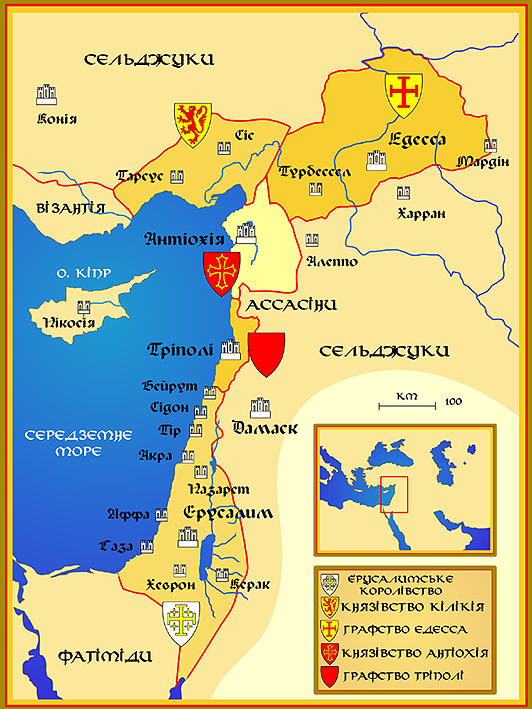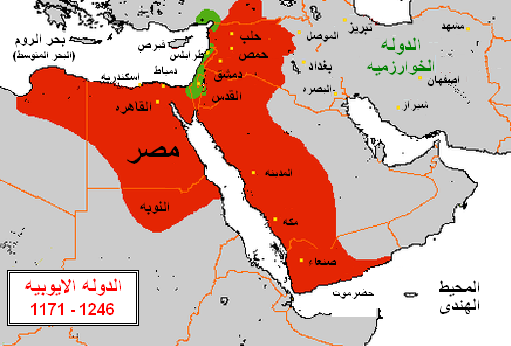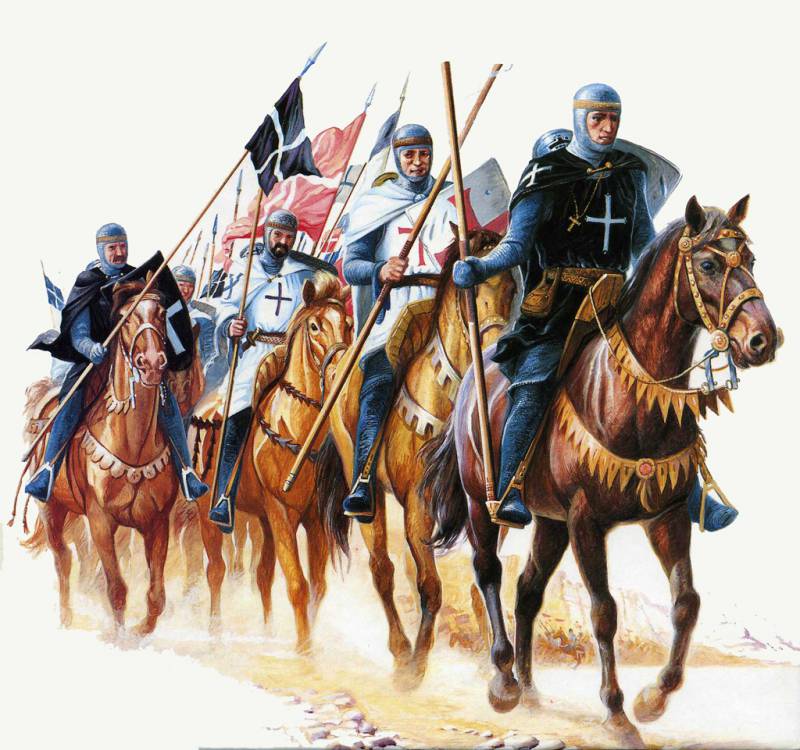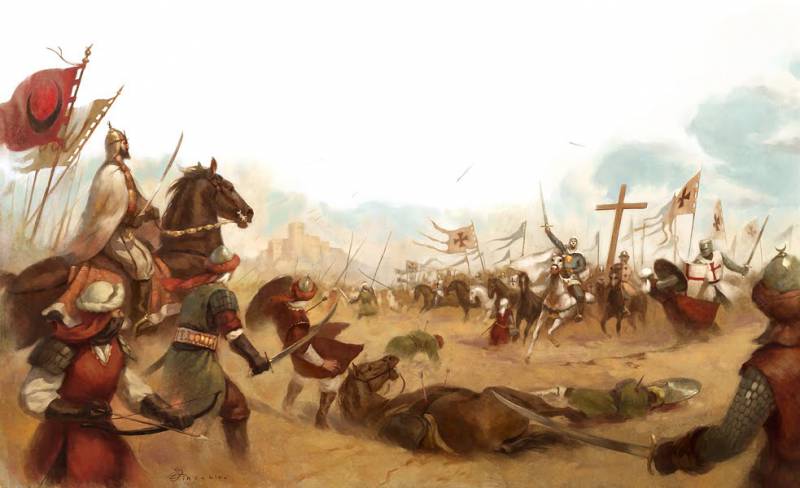Battle of Montjisar: as the young king of the mighty Sultan defeated. Part two
The course of the battle
So, at the end of November 1177, the huge sultan army, consistently defeating several Christian troops, relaxed somewhat (like Saladin himself), spread out over the kingdom of Jerusalem and engaged in looting. Moreover, the Sultan of Egypt and Syria considered the day of 27 to be happy for itself, “the day of triumph”, and apparently assumed that on that day he would be able to join Jerusalem, as a result of a light assault, 3 the year before he triumphantly entered Damascus. But 25 in November, 1177, suddenly everything changed suddenly - the army of the Islamists had to take the battle with a detachment of crusaders who had suddenly approached their camp.
The location of the battlefield is localized in different ways: some believe that Mons gisardi it's a hill Al-safiya at Ramla, other researchers admit that the battle took place at Tell as-safi , near modern settlement Menehem, next to Ashkelon; but one way or another, the battle took place on a flat area with ridges of hills, somewhere between Ashkelon and Ramla.

It should be noted that the shock forces of Balduin IV’s army still managed to avoid annihilation thanks to a quick march and excellent maneuvering. The fact is that his small infantrymen were not city militiamen (like the surrounded and destroyed Jerusalem arierbann), but foot and horse "sergeants", professional warriors, who used various "weedy" horses, mules and even donkeys for speed of movement, t. that is, in fact, they acted as the "dragoons" of the New Time or the "dimaha" of Antiquity, not inferior in speed of movement and professionalism to the knights. It was thanks to the speed that the surprise factor worked: under Montjisar, the “francs” managed to catch the “Saracens” by surprise.
However, Balduin IV still had very few warriors: about 450-600 knights as the main striking force (300 templar led by Grandmaster of the Order of the Temple Odo de Saint-Amandan, about 375 of the Hospitallers and a row other equestrian contingents). At the same time, the infantry riding (even in the dragoon version) in the army of Christians played only a supporting role and hardly fought in horse formation, whereas the Muslims had a great superiority in cavalry. The people of Jerusalem were in turmoil, for they saw before us a huge camp of the enemy army, and were aware of the insignificance of their chances. But there was nothing to do - Christians had to enter the battle with the fury of the doomed, in order to try to save the Holy City at the cost of their lives.
In addition, in their hands was a great Christian shrine - part of the Cross, on which Jesus Christ was crucified, which was found during excavations in Jerusalem by Queen Helena, mother of the Roman emperor Constantine. A part of this relic was built by the crusaders according to a Byzantine pattern in a cruciform battle standard, which became the main banner of the army of the Jerusalem kingdom.
Now we will hand over the word to the already familiar to us Patriarch of the Syrian Church Michael, in the chronicles of which one of the best descriptions of the battle of Montjisar has been preserved, in fact, this is a recorded story of the battle participant who remained nameless.
“... Everyone lost hope ... But God revealed all his power in the weak, and inspired the weak King of Jerusalem to attack; around him gathered the remnants of his troops. He came down from his horse, prostrated himself before the Holy Cross, and offered up a prayer ... At the sight of this heart, all the warriors trembled and were filled with hope. They laid their hands on the True Cross and swore that they would not leave the battle to the end, and if the wrong Turks had won, then those who tried to run and not die would be considered worse than Judah. And then they got into their saddles, moved forward and faced the Muslims, who were already celebrating the victory, because they believed that they had destroyed all the Franks before.
Seeing the Turks (as the Syrian hierarch calls all Muslim warriors), whose troops were like the sea, the knights dismounted again, cut off their hair; they hugged for reconciliation and asked each other for forgiveness for the last time, and then rushed into battle. At that very moment, the Lord raised a cruel storm, which raised dust from the Franks and drove it to the Turks. Then the Christians realized that God accepted their repentance and heard their prayer, they rejoiced and cheered ... ”
As is known from other testimonies, the Crusaders, offering prayers to Jesus Christ, the Blessed Virgin and the Great Martyr George, rushed to the attack, "putting everything on one card." At that time, Saladin, seeing a small but determined and ready for battle opponent, began to assemble his own regiments. However, despite the fact that only about 500 knight copies stabbed into the center of the Muslim army, the success was accompanied by Christians (sources do not report whether Christian infantry, which supported the knights' attack, attacked on foot or in horse formation).
If Saladin had shown himself at the hill of Mont-Gisar as a courageous and commanding general, then surely he could have turned the tide of battle in his favor. However, the “Piety of Faith” apparently liked to kill only unarmed prisoners (according to a chronicler, the sultan personally cut the throat of the first captured Christian soldier, apparently from a broken detachment of border guards - Turkopoli), while the prospect of a real hand-to-hand combat with an unknown result strongly frightened him. According to the testimony of a Muslim participant in the battle, a small detachment of knights, apparently led by the King of Jerusalem (less than 100 warriors), clearly focusing on the banner of the Sultan, made his way to his guardsmen, and so fiercely attacked them, 700-1000 warriors), gradually began to retreat. Faced with immediate danger, Saladin himself, and with him and his retinue, fled before any other warriors.
Seeing this, the soldiers of the Islamist army, already hesitating under the blows of Christians, realized that everything was gone, since the sultan himself was running, and they also ran. Attempts by junior officers to restore order in the ranks of the Muslims did not lead to anything; the senior officers ran immediately after their master. Let us give the floor to Mikhail Syriyu again: “... Incorrect Turks, on the contrary, hesitated, then turned around and fled. The Franks pursued them all day and took away many thousands of their camels and all their possessions. Since the Turkish troops scattered across the desert areas, the Franks took 5 days to search for them. ... Some of them, having reached Egypt, led by Saladin, dressed in black and were in deep mourning ... ".
The results and consequences of the battle
Fleeing always means a disproportionate increase in losses on the part of the loser, and the battle of Montjisar was no exception: the Crusaders had very little, and they simply did not have the strength to take prisoners in large quantities. In addition, Christians added bitterness to the fact that the Islamists apparently killed all the captured militias from the defeated Araderban, probably thinking that many slaves would be captured after taking Jerusalem, or they cut the prisoners, seeing that the battle was lost . Therefore, the persecution of fled Muslims lasted for a long time, and it was very fierce. Salahuddin himself escaped, according to an eyewitness, only by transferring from a horse to a fast camel, and practically did not get down from her to the very walls of Cairo.
The huge wagon train and the entire fleet of siege vehicles, which had been prepared beforehand with such difficulty, fell into the hands of the Christian army. The chronicles especially underline the incredible number of captured camels - their number was so great that their prices fell on the Middle Eastern bazaars several times. However, due to the fact that the entourage of Saladin fled one of the first, the top officers of his army (unlike ordinary warriors, especially infantrymen) killed little - only the death of Ahmad, the son of Taki Al-Din, a well-known commander and relative of Saladin, was known.
After the battle, the Sultan's office was taken over by the crusaders, including his personal, jeweled, copy of the Koran, which was presented to him earlier by the King of Jerusalem. At the conclusion of peace between Ayyubid Egypt and the Kingdom of Jerusalem in 1180, Balduin IV again presented this copy to the one to whom it was presented earlier, with the words: “You then lost to Mont-Gisara this present of mine. Take it again. You have already seen that it is not necessary for a lion to act like a jackal. I sincerely hope that you will no longer violate the peace between us and you, and I hope that I will not have to give this book to you a third time again. ”
Very revealing behavior after the battle of the Sinai Bedouins, who were apparently attracted by the Sultan to the march on Jerusalem with promises of rich booty. When the Muslim army ran, their contingent ran one of the first, and, realizing that the promised mining was not foreseen, they began to attack other fugitives from the sultan's army. According to eyewitnesses, the Bedouins killed very many of their fellow believers for the sake of minor trophies, and even tried to attack the retinue of Saladin himself.
The losses of Baldwin IV's army even in the decisive battle were very serious and amounted, according to the surviving letter of the Grand Master of the Hospital Order Roger de Moulins. (Roger des Moulins)1.100 people killed and 750 people. the wounded, who were transferred to the famous hospital in Jerusalem. To this must be added the several thousand dead of the Jerusalem infantry of the encircled militia and an unknown number of Turkopolans of the defeated vanguard.
The losses of Saladin’s army by both sides are estimated as catastrophic - up to 90% of the composition of the army, according to apparently an overestimation of Christian authors. But one way or another, the Muslim infantry (which could not escape from the horse-drawn warriors) suffered very much, while the Muslim cavalry (some of which were generally out of the battlefield, ruining the country) basically retained combat capability. And I must say that another confirmation of the huge losses of Muslims is that the regiments of the black Sudanese mercenaries in the army of Saladin never again reached such a number as they had before Montjisar.
The army of Christians, having won a tremendous victory, did not organize a strategic prosecution and moreover did not march on Cairo, because suffered heavy losses, and was physically and morally severely exhausted. In addition, a more pressing matter was the need to cleanse the center of the country from the marauding detachments that flooded it. But the Muslim army and so suffered huge losses, and most importantly - a direct threat to the very existence of the Kingdom of Jerusalem was removed for many years.
To commemorate the victory, Balduin IV ordered the construction of a Catholic monastery in honor of St. Catherine of Alexandria, the “defender of Christianity”, which had been martyred during the reign of Emperor Maximinus in Alexandria of Egypt, at the scene of the battle. victory was won on the day of her memory.

During the 8 years, while the winner was alive, Saladin well remembered the “lesson learned”, and did not dare to announce a new large-scale campaign “to Jerusalem”, making only disturbing raids on Christian lands. The Sultan of Egypt focused his main efforts on the annexation of the territories of other Muslim rulers, gradually capturing half of the Arabian Peninsula, most of Syria, Iraq, Eastern Libya, the whole of Sudan, and even part of Ethiopia. In fact, he managed to revive the declining Arab caliphate and gradually unite the entire Middle East (excluding the territories of modern Israel and Lebanon, which were part of the Crusader principalities) into a “single Islamic state” from Libya to Iraq, which is also the dream of its current ideological followers - jihadists from ISIL .
The Battle of Montjisar (Tel-Ac-Safita) was one of the greatest victories of the Crusaders in the Middle East and is considered one of the models not only of the commanding art of European knighthood, but also an example of how decisive tactics, heroism and dedication on the one hand allow to overcome, it seemed an incredible ratio, on the other hand, the cowardice of commanding personnel, indiscretion in the conduct of an offensive and low discipline with a great thirst for profit lead to the death of a huge army.


Information